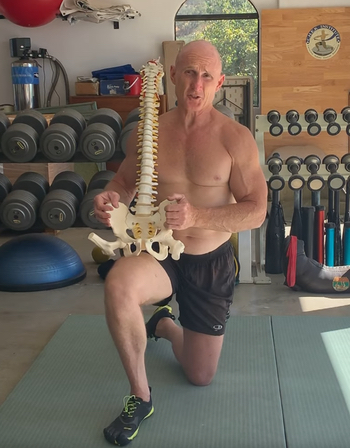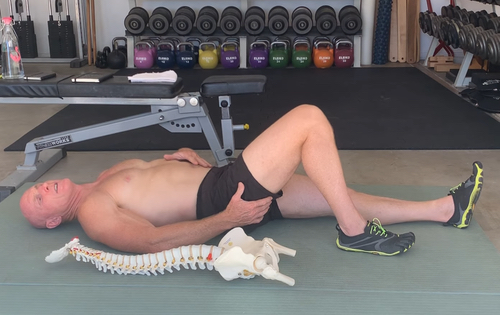The DonTigny Knee Reach
 Happy Monday everyone.
Happy Monday everyone.
I hope you’re enjoying my blogs/vlogs every bit as much as I like creating them. If you do, please share them!
This week, I’m going to show you how to perform the DonTigny Knee Reach, a corrective exercise that I’ve found to be the most effective for stabilizing sacroiliac (SI) joint instabilities.
(Richard DonTigny is one of the world’s leading experts on the SI joint and I have taken training courses with him in the past.)
These instabilities are so common, nearly all patients with low back pain also have a related SI joint dysfunction of some kind. (I get into these connected problems in various CHEK Advanced Training Programs.)
The abdominal wall and pelvic floor are very involved in stabilizing the SI joint.
Many people aren’t able to activate their abdominal walls naturally and effectively, which commonly happens due to unresolved back injuries and back pain, which may come from inflammation in the gut or any of the organs in the low back area. Even the kidneys, bladder, sex organs, sigmoid colon and small intestine can get involved because the abdominal wall from the T-5 vertebra down acts across the whole system.
These aren’t segmented relationships either. The whole abdominal wall is involved.
Research shows it only takes six pounds of pressure to stabilize the SI joint due to mechanical forces and the way it’s designed. But, if you don’t have a functional abdominal wall, that shuts down proper movement and can trigger health problems in many areas.
How to perform the DonTigny Knee Reach
As you’re lying on a mat, position your legs so the working one is bent and your free leg is stretching out. As you’ll see in my vlog, you’ll put gentle pressure on the heel (just enough to squash a marshmallow and no more than that).
If you overdo it, the muscle contraction will pull the two halves of the pelvis together, thus locking the joint so you can’t mobilize it.
To show you how this works, place your fingers on the hamstring that’s bent. Then, put a little pressure on your heel connected to that leg, until you feel the hamstring fire up.

While you’ve got some pressure on that heel, move the knee forward, but not so much that you’ll roll over or fire up other muscles. Hold that for five seconds, then relax it for five seconds.
What’s happening is you’re rolling the pelvis posteriorly by using contractions from the hamstrings and leaving the rest of the muscles relaxed.
It’s good to do this on both sides even if the other one is working fine. It’s OK to do this because, once the system reaches its natural tension, it can’t be made any tighter.
Because this is a very simple, gentle exercise, if your ligaments are unstable, learning and using this exercise will bring it back into balance.
If you notice improvements but still have SI joint pain, you’ll probably need a special SI belt that wraps around your hips (it creates hoop tension that holds both halves of the pelvis together, so you can take pressure off the ligaments and joint and allow it to heal).
Typically, you’ll do three to five reps on each side, and perform three to five sets of reps or until you feel the greatest amount of relief (or it’s not doing anything anymore).
The mysterious root cause
Although the DonTigny Knee Reach may alleviate your pain, there’s a lot of factors that can lead to SI joint dysfunctions so it won’t necessarily show you what’s causing it.
I’ve seen a number of cases where the root cause was psychological, such as people having insecurities and issues and self-judgements around sex blocking the flow of energy, leading to a musculoskeletal dysfunction that mirrors their mental state.
And, I’ve seen problems of a more physical nature too, like cancer, chronic constipation, fungal and parasite infections, surgical scars and visceral adhesions.
My hope is that this exercise can give you some relief, at least until you can get more help from a skilled CHEK Professional or someone who knows what they’re doing.
You can learn much more about these kinds of corrective exercises by taking my Scientific Back Training, Scientific Core Conditioning and Program Design courses.
If you want to go even deeper, I hope you’ll consider taking Integrated Movement Science Level 1 (previously CHEK Exercise Coach).
I’ll be back next week with another dive into Dr. Movement!
Love and chi,
Paul